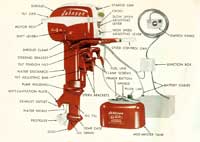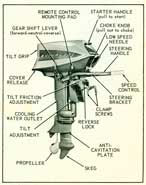| by
Max Wawrzyniak - St Louis, Missouri - USA
A
Question From a Reader
|
 |
The following message was posted in response to one
of my columns:
"...Max, I enjoy reading your articles.
I think it's time we moved into the 1970's though,
dont you? Or is that too modern for your audience?..."
It is a valid question and a question that I am sure
many readers have wondered about: "Why does Max
keep harping on these old 1950's outboards when there
are much newer (but still old) outboards around??"
There are a couple of answers to this question, the
first being a matter of economics. Around these parts
(midwest USA) the older the outboard, the cheaper
it is to buy, until the outboards get so old as to
be considered "antique." According to the
Antique Outboard Motor Club (aomci.og) any outboard
motor built in 1950 or before is considered "antique,"
while an outboard motor built in 1951 or after, and
which is at least 30 years old in the current year,
is a "classic."
 |
This 1958 Johnson
18 hp is mechanically very similar to....
(click images
to enlarge) |
The old outboards that I always recommend (smaller
OMC-built outboards from about 1955 to the early 1970's)
would all fall into the "classic" designation
although as time marches on I don't doubt that at
some point they will be reclassified as antiques.
While "showroom-new" examples of these 1950's
outboards are rising in value, the rather "beat"-looking
versions (dents, scratched/missing paint, etc.) are
still fairly cheap to buy although you want to be
sure that "beat" applies only to the cosmetics
and not the mechanicals.
And the mechanicals of a late-'50s OMC's of up to
about 40 hp are not much different than those of a
late '60s or even early '70s OMC's of similar horsepower.
Very few mechanical changes were made during that
period in the smaller outboards, although there were
some dramatic changes in the larger (over 40 hp) versions.
If you have worked on a 1958 Johnson 18 hp, for example,
you will feel right at home working on a 1972 Evinrude
18 hp or 25 hp.
 |
.... this 1965
Evinrude 18 hp, and both of these 18's are mechanically
very similar to.... |
For some reason people (at least the ones that I
am familar with) would never consider mowing their
lawn with a 1960's or 1970's era lawn mower, nor would
they rely on a 1960's or 1970's era auto to get them
to work every day. Yet these same people consider
a 1975 outboard motor to be a "late model,"
and price it accordingly. So that 1972 18 hp Evinrude
that I mentioned above will almost always carry a
higher price than than the 1958 version even though
both engines are ALMOST ( not quite) identical mechanically.
I believe that I am not amiss to say that none of
us get to spend as much time on the water as we would
like, and "ordinary" boaters and anglers
are no different. The amount of use that the 1972
outoard has seen over it's lifetime will probably
not be significantly less than that of the 1958. Certainly
not enough to justify a significantly higher price.
Bottom line is that I see little advantage to paying
a premium for a 1960's version over a 1950's version.
 |
....Johnson
and Evinrude 25 hp models made up through 1974 |
I should point out that it is anglers that place
the premium on the 1960's versions: collectors would
probably prefer the older version, but anglers far
out number collectors and so they are making the market.
In the 1970's things start to get a little more complicated,
because the engines themselves started to change.
The early to mid '70s brought on the advent of electronic
ignition which sometimes can be easily damaged by
inexpert tinkering and with components that can be
expensive to replace. Not every model had electronic
ignition, however: I once had a 1981 4 hp Evinrude
that had the same "old-fashioned" points
and condenser ignition system that the 1951 3 hp models
had. Actually, other than a "modern" looking
plastic cowl and gas tank, it was almost identical
to that 1951 3 hp.
Other complications introduced in the 1970's included
"one-piece"
lower unit housings that required special tools and
specialized knowledge to repair, and the advent of
"low-profile" designs that appealed to buyers
but which sometimes made repairs difficult to effect.
Probably the worst of the OMC low-profiles to work
on is the 1965 to 1973 9 1/2hp. I would MUCH rather
work on an earlier 10 hp than one of these 9 1/2's.
The 6 hp, introduced in 1965, is a bit easier to work
on than the 9 1/2, but not as easy as the 5 1/2 hp
it replaced.
|  There
are many many MANY of these 9 1/2 hp low-profile
"pancake" engines out there. Made
from 1964 through 1973 they came in both the
Johnson and Evinrude names and in several different
color schemes: this example, for sale on e-bay,
has been repainted. These are not my choice
for "easiest outboard motor to work on." There
are many many MANY of these 9 1/2 hp low-profile
"pancake" engines out there. Made
from 1964 through 1973 they came in both the
Johnson and Evinrude names and in several different
color schemes: this example, for sale on e-bay,
has been repainted. These are not my choice
for "easiest outboard motor to work on."
|
The "pancake" 9 1/2 was replaced in 1974
by 9.9 hp and 15 hp models. The 9.9 is the model that
all fisherman (it seems) want to convert to a 15 by
merely "changing the carburetor." They are
of the opinion that the 9.9's are merely "derated"
15s. My opinion is that the 15's are "over-rated"
9.9's. I once broke a crankshaft in a 15 (while in
reverse and backing away from a boat dock) so that
may have biased my opinion (by the way, it was not
my motor).
At just over 13 cubic inches, I think that getting
15 hp out of one of these is a bit of a stretch, although
9.9 hp is certainly fine. I don't like to see more
than one horsepower per cubic inch; more than that
and I feel that the engine is being overstressed.
Others would argue the point. I should point out that
my beloved old 18's have 22 cubic inches.
Like the hot rod guys say, "you just can't beat
cubic inches."
 |
1974 was the
first year of the 9.9 / 15 and these models
were made up into the 1990's, albiet with a
number of changes over the years. These are
a bit easier to work on than the 9 1/2, but
as they are much newer they are almost always
much more expensive to buy. |
The 9.9's and 15's have been around now for over
30 years and although they usually bring a high price
in my area you might run across a bargain on one,
in which case I can't really offer much help to you
on it's maintenance and repair other than to refer
you to an excellent
website on these particular models.
Although I would probably buy a 9.9 or 15 that came
my way "cheap," I still think I would rather
have an older 10 or 18 .
But to each his own.
Which is the main reason that I am not going to be
of much help with 1970's and newer outboard motors;
I am simply too cheap to buy them so I have not worked
on too many of them.
But as time goes on and they get older and cheaper...
Happy Motor'n

click
here for a list of Columns by Max Wawrzyniak |